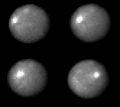Податотека:Ceres Rotation.jpg

Големина на овој преглед: 676 × 600 пиксели. Други разделности: 270 × 240 пиксели | 541 × 480 пиксели | 880 × 781 пиксели.
Изворна податотека (880 × 781 пиксели, големина: 94 КБ, MIME-тип: image/jpeg)
Историја на податотеката
Стиснете на датум/време за да ја видите податотеката како изгледала тогаш.
| Датум/време | Минијатура | Димензии | Корисник | Коментар | |
|---|---|---|---|---|---|
| тековна | 09:53, 30 јануари 2006 |  | 880 × 781 (94 КБ) | Arnomane | higher resolution |
| 15:17, 9 септември 2005 |  | 300 × 300 (4 КБ) | Vesta~commonswiki | {{Information| |Description = NASA's Hubble Space Telescope took these images of the asteroid 1 Ceres over a 2-hour and 20-minute span, the time it takes the Texas-sized object to complete one quarter of a rotation. One day on Ceres lasts 9 hours. The bri |
Употреба на податотеката
Податотекава се користи во следнава страница:
Глобална употреба на податотеката
Оваа податотека ја користат и следниве викија:
- Употреба на ba.wikipedia.org
- Употреба на be-tarask.wikipedia.org
- Употреба на bs.wikipedia.org
- Употреба на ca.wikipedia.org
- Употреба на ca.wikinews.org
- Употреба на cs.wikipedia.org
- Употреба на el.wikipedia.org
- Употреба на eo.wikipedia.org
- Употреба на es.wikinews.org
- Употреба на fa.wikipedia.org
- Употреба на fr.wikipedia.org
- Употреба на hu.wikipedia.org
- Употреба на hy.wikipedia.org
- Употреба на id.wikipedia.org
- Употреба на it.wikipedia.org
- Употреба на ja.wikipedia.org
- Употреба на ka.wikipedia.org
- Употреба на ko.wikipedia.org
- Употреба на mwl.wikipedia.org
- Употреба на nl.wikipedia.org
- Употреба на no.wikipedia.org
- Употреба на oc.wikipedia.org
- Употреба на ru.wikipedia.org
- Употреба на sk.wikipedia.org
- Употреба на te.wikipedia.org
- Употреба на tl.wikipedia.org
- Употреба на zh.wikipedia.org

